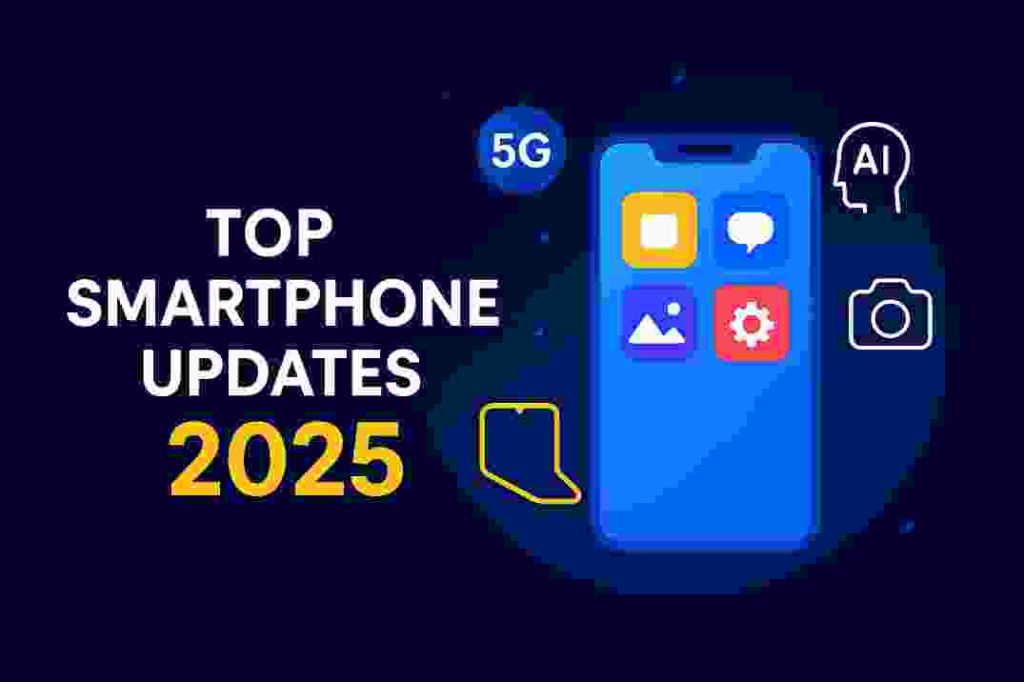The latest phone updates – from software patches to hardware innovations – are dramatically enhancing how we use our mobile devices. Faster connectivity, smarter cameras, and powerful on-device AI are now standard. For example, 5G networks already carry over 35% of all mobile data, vastly improving speed and reliability.

Analysts also note growing adoption of foldable displays: global market share of foldables rose from 0.5% in 2021 to 1.6% in 2023. At the same time, virtually every new phone release in 2024 emphasized artificial intelligence (AI) – as one review put it, “the biggest trend in smartphones this past year” was AI-powered features.
Many of these innovations come through over-the-air updates and new OS releases. In 2024–2025, major Android and iOS updates have unlocked new capabilities: Android 16 and iOS 17 (and soon iOS 18) introduced features like advanced privacy controls, AI assistants, and redesigned user interfaces.
Meanwhile, hardware advances (more powerful chips, better batteries, 5G modems) work in tandem with software to redefine mobile experiences.
Here are the top smartphone update trends reshaping mobile use today:
- 5G and Beyond: New cellular and Wi-Fi standards (5G, Wi-Fi 6E/7) dramatically boost speed and coverage.
- Software/OS Enhancements: Latest Android and iOS updates add features like smarter notifications, multitasking UIs, and improved privacy protections.
- On-Device AI: Phones now include AI assistants, smart cameras, and generative tools (e.g. chatbots and language translators) for smarter tasks.
- Cameras & Imaging: Ultra-high-resolution sensors and computational photography deliver better photos and lossless zoom.
- Foldable & New Designs: Innovative form factors (foldable phones, rollable displays, modular components) are becoming practical options.
- Battery & Charging: Cutting-edge batteries and ultra-fast charging (100–240W+) drastically reduce recharge times.
- Privacy & Security: System updates now include stronger encryption, fraud detection, and anti-tracking features.
Each of these areas is discussed below with examples and data. Together, these phone updates are making smartphones faster, smarter, and more versatile than ever.
5G and Next-Generation Connectivity
Modern phone updates heavily focus on connectivity. 5G networks have rolled out worldwide: according to Ericsson, 5G accounted for 35% of mobile data traffic by late 2024 (up from 26% a year earlier). This multi-gigabit network dramatically speeds downloads, reduces latency, and enables new services (like cloud gaming and high-res video streaming). Looking ahead, research forecasts 5G will carry the vast majority of traffic (80%) by 2030.
At the same time, phones support faster Wi-Fi. The 6GHz band (Wi-Fi 6E) and the emerging Wi-Fi 7 standard are now common in new handsets. Intel data shows over 5,000 devices (mostly PCs but including smartphones) now support 6GHz Wi-Fi, and more than 1,200 devices (including ~169 phones) support Wi-Fi 7.
These upgrades allow multi-gigabit Wi-Fi on phones, useful for local streaming or fast tethering. Other advances include global connectivity (e.g. eSIM profiles that switch carriers without a new SIM) and satellite links. For instance, satellite emergency SOS and emerging “direct-to-cell” satellite services aim to keep phones connected even off-grid.
Key takeaways: Phone updates now deliver next-gen connectivity – 5G is mainstream (35% of global data), and new Wi-Fi standards are arriving. These network upgrades are a core part of mobile experience improvements.
Software and Operating System Enhancements
Every year, smartphone manufacturers release major OS updates packed with new features. For example, Android 16 (late 2024) introduced features to streamline daily use: forced notification auto-grouping (to declutter alerts), “Live Updates” that surface progress bars in notifications (showing delivery or ride status without opening an app), and Desktop Windowing on tablets for PC-like multitasking. Android 16 also added one-tap “Advanced Protection” for security, haptic feedback on sliders, and HDR screenshot support.
On the Apple side, iOS 17 (2023–2024) brought notable changes. Apple’s update notes highlight “big updates to Phone, Messages, and FaceTime,” a new StandBy mode (turning the iPhone sideways while charging into a glanceable display), enhanced AirDrop with NameDrop for easy contact sharing, and smarter keyboard features. Subsequent iOS 17.x updates added things like new emoji, improved Podcasts transcripts, and cross-platform tracker alerts (if an unknown Bluetooth tracker like an AirTag moves with you). Apple has also promised more Apple Intelligence (its on-device AI suite) in upcoming iOS versions.
These system-level updates (both Android and iOS) are delivered as free software updates, ensuring even older handsets get new features. Users often get annual OS upgrades plus monthly security patches. As a result, modern phones can gain new capabilities years after purchase.
- Android’s official site lists fresh Android 16 features (notification grouping, zoom on tasks, etc.).
- Apple’s support site notes the main iOS 17 highlights (StandBy mode, NameDrop AirDrop, Widgets improvements).
In short, software updates today do much more than fix bugs: they upgrade user interfaces, add AI tools, and enhance privacy protections (for example, Android 15 will hide one-time passwords from notifications and expand fraud-detection features). Keeping your phone’s OS up to date is one of the easiest ways to benefit from these ongoing improvements.
Artificial Intelligence on Phones
Smartphone displaying an AI chatbot interface. Modern phone updates increasingly integrate AI features (e.g. on-device assistants, generative tools) to make phones smarter.
AI has become a central theme in recent phone updates. In 2024, manufacturers pushed on-device AI assistants, on-picture editing, and other machine-learning enhancements. Tech analysts observed that “Artificial intelligence led off and finished just about any conversation” about new phones in 2024. Major brands are competing: Google’s Pixel phones (with Tensor G4 chips) offer features like real-time language translation and photo editing. Samsung’s Galaxy S24 introduced “Galaxy AI” capabilities (for example, the Circle to Search visual search tool on any content). Apple entered the fray with “Apple Intelligence,” adding AI-powered writing and summarization tools to Messages and Mail.
Some concrete examples of AI in the latest phone updates:
- Smart assistants: Enhanced voice assistants can schedule tasks from chats or summarize email threads automatically. For instance, iOS 18’s Mail app can summarize long emails with a tap.
- Image generation: Phones can generate or edit images from text prompts. Both Android and iOS developers are integrating generative AI for creative apps.
- Photos and video: AI-powered camera modes suggest the best shots, remove objects, and upscale low-light images. Google’s “Magic Eraser” and Apple’s new portrait lighting modes rely on on-device AI.
- Smart features: Tools like AI-driven call screening (to block spam calls) and on-device language translation use powerful local neural engines. Samsung’s phones use “Circle to Search”: draw a circle around anything on screen to instantly search for information.
In short, phone updates now mean smarter phones. Processors like Apple’s A-series and Qualcomm’s 8-series include dedicated neural units, enabling these AI features without always needing the cloud. According to industry observers, every flagship in 2024 packed more AI tools than before. As a result, routine tasks (emails, photo editing, translations) are getting faster and more automated via phone updates.
Camera and Imaging Improvements
High-end smartphone updates increasingly focus on camera technology. Users expect sharper photos, more optical zoom, and sophisticated processing. Recent updates showcase ultra-high-resolution sensors and computational photography. Samsung’s new 200MP sensors (ISOCELL HP2/HP3) illustrate this trend: these chips enable up to 4× lossless in-sensor zoom, so that digital zoomed images match the quality of an optical 3× telephoto lens. In practice, a 200MP sensor can output a 12.5MP photo at 1×, 2×, or 4× zoom with no detail loss. This bridges the gap between wide-angle and telephoto cameras on phones, giving users high-quality zoom shots without a bulky optical lens.
Phones also deliver better low-light and video. New camera firmware updates improve HDR and noise reduction. For example, Google and Apple both enhance night modes via software in each OS release. Major flagship models now routinely offer features like 8K video recording, multi-frame HDR, and advanced stabilization. Some phones use AI burst capture to combine multiple exposures on fast-moving subjects for a clear shot.
In summary, camera updates in phones include:
- Larger sensors (up to 1-inch type) and more megapixels (48–200MP) for detail.
- Improved zoom (periscope lenses and AI-driven zoom).
- Enhanced computational modes (portrait lighting, action mode, improved panorama).
- Better video (higher frame rates, HDR10+ video, dynamic range).
Citations: Samsung’s tech blog explains the 200MP in-sensor zoom breakthrough, and independent reviews note that the latest camera phones (e.g. Galaxy S24 Ultra, iPhone 16 Pro) push imaging quality higher each year.
Foldable Phones and Novel Designs
Foldable smartphones, once niche, are maturing. These devices offer tablet-sized screens in a pocketable form factor, allowing new multitasking experiences. According to a UX research group, foldable market share grew from only 0.5% in 2021 to 1.6% in 2023, and is projected to reach ~5% by 2028. China leads foldable adoption (4.1% of phones in China are foldables). In late 2024, rumors even swirled about Apple planning a foldable iPhone (reflecting growing interest).
Common foldable designs today include “fold-out” (tablet-like when open, e.g. Samsung Galaxy Z Fold series) and “flip” (clamshell style, e.g. Galaxy Z Flip). Phone updates for foldables often focus on optimizing the UI: for example, Android’s foldable support has improved task continuity and multi-window when you open or close the device. One study participant described using a Z Fold at work like carrying an iPad replacement – unfolding blueprints on the go.
Foldable smartphones (Samsung Galaxy Z Fold and Z Flip series) are an emerging form factor. Update cycles optimize software for folding screens, enabling tablet-like multitasking on phones.
Manufacturers are also experimenting beyond single folds. Huawei unveiled a tri-fold model with three states (phone, medium tablet, full tablet). These advances mean future phone updates will likely include better support for multiple screen modes and new UX paradigms. For now, foldables bring richer experiences for multitasking, and their rise is a notable hardware update trend.
Battery Technology and Charging
Battery life and charging speed remain key user concerns, and smartphone updates address them on both hardware and software sides. On the charging front, manufacturers have pushed ultra-fast wired charging: 100W–240W chargers are now available on some models.
For example, the Realme GT Neo 5 (2023) supports up to 240W charging, capable of charging a 4600mAh battery to 100% in under 10 minutes. (For perspective, 210W was the previous record on the Redmi Note 12 Discovery.) Real-world use is subject to heat and safety limitations, but even today’s 100W+ chargers can fill a phone from 0 to 50% in minutes. Many updates also include smart charging software: battery management algorithms slow charging near full, and “Adaptive Charging” learns your schedule to prolong lifespan.
On the battery hardware side, new chemistries and form factors are emerging. Companies are experimenting with silicon anodes, graphene composites, and solid-state cells for higher density and safety. While not all breakthroughs are in consumer phones yet, update cycles increasingly support features like more granular battery usage stats and eco-saving modes.
Software updates also help extend runtime: power-saving modes throttle background apps more intelligently, and AI can learn your habits to shut down unneeded services. New Android and iOS releases often include “Extreme Power Saving” modes or revamped battery usage graphs.
Summary: Charging technology is leaping forward: some phones now charge fully in minutes thanks to 100–240W systems. Meanwhile, software updates optimize how power is used, resulting in longer battery life between charges.
Privacy, Security, and Trust
Modern phone updates place a premium on security and privacy. Major OS releases add protections to guard user data and fight fraud. For instance, Android 15 (rolling out in 2024–2025) includes measures to combat scams: one-time passwords are hidden from notifications (thwarting malware that sniffs OTPs) and on-device AI (Gemini-Nano) can detect scam calls in real time. Android 15 also warns users if their cellular connection isn’t encrypted (protecting against fake base stations). Google’s Play Protect now scans over 200 billion apps daily for threats, and Android’s privacy “photos picker” now integrates cloud storage, limiting broad photo access.
Apple’s updates similarly bolster privacy. Recent iOS versions include features like Advanced Data Protection (end-to-end encrypting backups) and Cross-Platform Tracking Detection: your iPhone will notify you if an unknown Bluetooth tracker (AirTag, Tile) is moving with you, even if paired to an Android device. System updates also sandbox apps more strictly, and app stores (Apple’s and Google’s) enforce tighter permission rules (e.g. requiring justification for accessing all photos).
Regular security patches (often monthly) fix vulnerabilities as they are discovered. Many phones now automatically download and apply patches in the background. Overall, recent smartphone updates are about trust – keeping personal data safe and preventing unauthorized tracking. According to a tech expert, Android’s new security suite combines on-device scanning and advanced encryption to stay “ahead of scammers, fraudsters and bad actors”.
Other Emerging Features
Beyond the big trends above, other phone updates continue to add value:
- Augmented Reality (AR): Frameworks like ARCore and ARKit are updated to support better tracking and display. Phones (especially with LiDAR or 3D sensors) are increasingly used for live translation and navigation (e.g. Google Maps’ Live View AR directions).
- Health and Sensors: Flagship phones now include or pair with biomedical sensors (ECG, temperature) and pulse oximeters. Software updates have added features like heart-rate monitoring through the camera and advanced sleep tracking analytics.
- Connectivity Features: Updates often improve things like Bluetooth LE Audio support (better audio efficiency) and digital car key / smart home integration. For instance, newer iPhones support sharing digital car keys via updates, and Android 16 introduced seamless switching for hearing aids.
- User Interface Tweaks: New UI patterns appear: for example, dynamic lock screens (as in iOS 16/17) or smoother animations (Android’s new gesture hints).
These incremental updates might not make headlines, but combined they refine the user experience. For example, a recent Android update added “Haptic Sliders” so volume and brightness sliders give tactile feedback. That’s a tiny change, but many such refinements add up.
Conclusion
Phone updates in 2024–2025 have brought radical improvements to smartphones. From blazing-fast 5G and Wi-Fi connectivity to foldable displays and AI assistants, each update cycle is redefining the mobile experience. Operating system upgrades are introducing powerful new features (like on-device AI and stronger privacy controls), while hardware advancements (higher-res cameras, faster charging) push capabilities further. Together, these updates make phones more powerful, versatile, and secure than ever.
Smartphone users benefit by simply installing the latest updates: improvements to speed, security, and functionality arrive automatically. And as manufacturers promise multi-year update support, even older devices can gain many of these new features.
What smartphone update are you most excited about? Share your thoughts below or on social media! (Your feedback helps inform future improvements and keeps the conversation going.)
FAQs
Q: Why are phone updates important?
A: Phone updates deliver new features and fixes that improve performance, security, and functionality. They can bring major enhancements (like 5G support or AI assistants) to your device. Staying updated ensures you have the latest smartphone innovations and protections.
Q: How do software updates improve my phone?
A: Software updates (Android or iOS versions, plus patches) can add new capabilities (e.g. Widgets, Live Text, multi-app screens) and strengthen security (new encryption or anti-fraud tools). They also often boost stability and battery efficiency.
Q: What are the hottest hardware upgrades in phones?
A: Recent hardware trends include foldable/dual-screen designs, ultra-high-megapixel cameras with lossless zoom (up to 4×), and vastly faster charging (100–240W). These are paired with more powerful chipsets for AI and graphics.
Q: Will all phones get these updates?
A: It depends on the manufacturer. Flagship devices typically get major OS updates (usually for 2–3 years) and security patches longer. Budget or older models may get fewer updates. Brands like Google, Apple, Samsung and OnePlus have committed to longer update support, so newer premium phones will see the latest features.
Q: How can I make sure I get phone updates?
A: Enable automatic updates in your phone’s settings. For Android, go to Settings > System > Software Update (or similar) and turn on auto-update. For iPhone, go to Settings > General > Software Update and enable automatic updates. Keeping your OS and apps current ensures you benefit from all improvements and security fixes.


